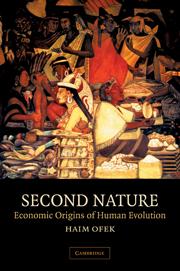Book contents
- Frontmatter
- Contents
- Acknowledgments
- 1 Introduction
- Part 1 Bioeconomics
- 2 Exchange in human and nonhuman societies
- 3 Classical economics and classical Darwinism
- 4 Evolutionary implications of division of labor
- 5 The feeding ecology
- 6 The origins of nepotistic exchange
- 7 Baboon speciation versus human specialization
- Part 2 Paleoeconomics
- References
- Index
7 - Baboon speciation versus human specialization
Published online by Cambridge University Press: 06 July 2010
- Frontmatter
- Contents
- Acknowledgments
- 1 Introduction
- Part 1 Bioeconomics
- 2 Exchange in human and nonhuman societies
- 3 Classical economics and classical Darwinism
- 4 Evolutionary implications of division of labor
- 5 The feeding ecology
- 6 The origins of nepotistic exchange
- 7 Baboon speciation versus human specialization
- Part 2 Paleoeconomics
- References
- Index
Summary
The chimpanzee is our closest nonhuman relative and, on the whole, is probably the best animal model of human individual behavior. A society of chimpanzees, however, is not necessarily the best model of human society. Strictly in terms of group behavior, humans may bear – perhaps uncomfortably – a closer resemblance to a society of baboons. In fact, of all the animals that live in groups, only the baboons provide a model of group formation (known as the fusion-fission system, after Kummer, 1997) that defines the very concept of a group in a sense applicable to human society. Ironically, the baboon is a quadruped dog-snouted primate that on a phylogenetic scale occupies a place nowhere as nearly related to humans or chimpanzees as both are related to each other. Darwin was keenly aware of this fact but, nonetheless, made nearly twice as many separate references to baboons than to chimpanzees in the Descent of Man (see Box 7.1). Almost a century later the importance of the baboon's ecology and society to the study of human evolution (especially in its Australopithecine stage) was recognized in the literature following an influential paper by DeVore and Washburn (1963). The present discussion further follows the evolution of the baboons in an attempt to better understand some conceivable early indications for the existence of human exchange. On this issue and a few others (e.g., sex-roles and warfare) I have found the insights gained from the natural history and social structures of the baboon to be more helpful than comparable insights gained from the chimpanzee or other apes. Perhaps we have something in common with a monkey that we do not share with an ape.
- Type
- Chapter
- Information
- Second NatureEconomic Origins of Human Evolution, pp. 105 - 122Publisher: Cambridge University PressPrint publication year: 2001

